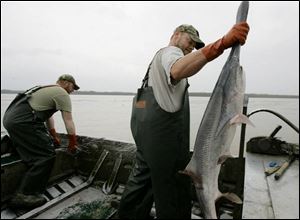
Ohio River caviar raises questions
7/11/2008
Charlie Hopkins, right, deposits a paddlefish as Vincent Halligan works the net at Smithland, Ky. Kentucky, Indiana, and Tennessee advise limited intake of caviar from the paddlefish.
SMITHLAND, Ky. - The buzz of an outboard motor sends pelicans skyward as Charlie Hopkins' skiff glides along the Ohio River to paddlefish nets placed beneath the murky surface.
The snowy-white birds watch from a distance as Mr. Hopkins pulls aboard huge, ugly fish, their bellies swollen with grayish eggs headed for extravagant restaurants, cruise ships, and gourmet stores.
As demand for paddlefish caviar has grown, health officials have become as uneasy as the gawking pelicans about a variety of toxins found in the eggs, including mercury, chlordane, and cancer-causing polychlorinated biphenyls, or PCBs.
But advocates say the level of contaminants is below federal safety standards and that most consumers don't eat enough of it to suffer any ill effects.
Kentucky, Indiana, and Tennessee have issued advisories warning consumers to limit their consumption of paddlefish caviar from portions of the Mississippi, Ohio, and Tennessee rivers.
Yet it can be difficult to know the sourcing of the caviar because the U.S. Food and Drug Administration and Department of Agriculture do not require companies to list the river of origin on their labels.
"If I were a consumer of that product, which I'm not, but if I were, I would want to know," said U.S. Fish and Wildlife Service agent Paul Beiriger.
Severe fishing restrictions in the Caspian Sea have led caviar fans to seek domestic alternatives to the prized eggs of Russian sturgeon.
Many connoisseurs rank the homely paddlefish - native to the Mississippi and its tributaries - high on their lists of suitable alternatives.
"It's relatively mild, so it appeals to a wide range of people," said Massachusetts caviar retailer Rich Brauman, who deals in the farm-raised variety. And at $25 an ounce, it's far more affordable than imported caviar.
Fishermen have converged on the Ohio River in search of the fish, also known as spoonbills, which can grow up to 200 pounds.
They are filter feeders that collect plankton by swimming with their mouths open. In the process, they collect large concentrations of pollutants, said Rob Mottice, a paddlefish expert at the Tennessee Aquarium in Chattanooga.
Commercial fishermen collect 5 to 10 tons of Ohio River paddlefish caviar each year, but while people in the region may have heard warnings about contaminants, others likely haven't, said Benjy Kinman, head of Kentucky's fisheries program.
Even retailers who sell the caviar may not know about the consumption advisories, including Texas-based Whole Foods Market, whose suppliers get paddlefish caviar from several rivers, including the Ohio.
Libba Letton, a spokesman for the national retailer of natural and organic foods, said the company only learned of the consumption advisory after being contacted by the Associated Press and is reviewing the matter.
Kentucky wildlife officials want the authority to require caviar harvesters to turn over sales information, which would allow the agency to determine precisely how much is hitting the market.
The state is also preparing to reissue its long-standing advisory warning that children and women of childbearing age should never eat the caviar, and that other healthy adults should eat it no more than six times a year.
Tennessee officials went beyond a consumption advisory, opting to ban all commercial fishing on a 30-mile stretch of the Mississippi River around Memphis after contaminants, including mercury and chlordane, were found in fish there.
"A commercial fisherman is harvesting for other people, and the people consuming the fish may not know about the advisory," said George Scholten, head of the Tennessee Wildlife Resources Agency's commercial fishing program.
The level of PCBs found in paddlefish eggs is less than 1 part per million, said Eric Eisiminger, a researcher for the Kentucky Division of Water, and the FDA doesn't consider PCBs a concern until they reach at least 2 parts per million.
But it's up to states to make the call on when advisories should be issued, FDA spokesman Veronica Castro said
Mr. Hopkins, the Kentucky fisherman, said common sense suggests that people don't eat enough caviar to be affected by the contaminants.
It's a delicacy eaten by most people only during special occasions and then only in tiny amounts, he said.
Even so, caviar distributors like Lewis Shuckman, owner of Shuckman's Fish Company & Smokery Inc. in Louisville, said he avoids caviar from the nearby Ohio River because of the pollution.